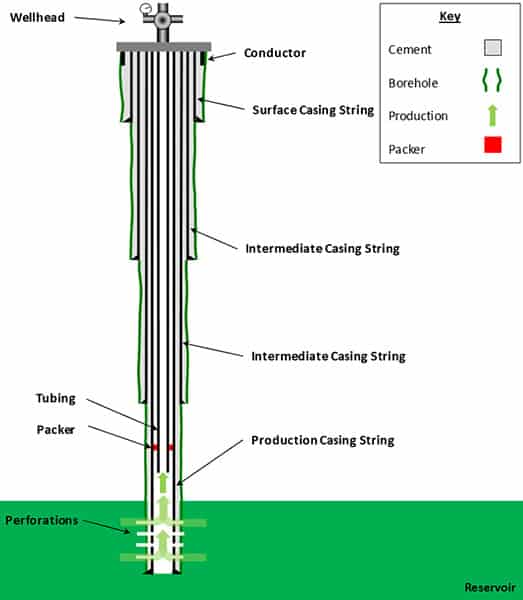Constructing the well involves installing the casing and cementing the casing in place. Engineers refer to the process as ‘setting casing’ in the well. Casing is set at different intervals during the drilling process. Engineers will also refer to a ‘string’ of casing. A string is a long section of connected pipe of common diameter, and most wells will have multiple casing strings installed.
An image of the various types of casing, as well as a few other wellbore items, will help you better understand how the well is constructed, and finally, how fluids are produced out of the well. Remember, during the drilling process, engineers want to prevent formation fluids from the reservoir flowing up the well. Once casing and cementing is completed, however, the well moves to the production phase when an engineer wants reservoir fluids flowing up the well.
Each length of casing must fit within any previously installed casing string to be installed, which means that as a well is drilled deeper and subsequently casing strings are set, casing diameters need to be successively smaller. With that in mind, let’s take a look at several types of casing used in drilling a well and some typical sizes.
Conductor Casing
Conductor casing is drilled-in or driven-in pipe. It does not support any loads of consequence and cannot be used for pressure control. This casing isolates unconsolidated formations and water sands and protects against shallow gas, as well as stabilizing the ground at the well site on top of which the drill rig is installed. When cemented, conductor casing is typically cemented to the surface or to the seabed, often referred to as the mudline, in offshore wells.
Size: Conductor casing can normally vary from sizes such as 18″ to 30″, and varies between onshore (smaller) to offshore (larger).1Wikimedia Foundation. (2020, December 15). Casing (borehole). Wikipedia. https://en.wikipedia.org/wiki/Casing_(borehole).
Surface Casing
Surface casing is installed after the conductor casing is set, and is the most important string to protect shallow freshwater zones. It also serves to prevent pressure in the well from escaping outside the well to the surface, and provides the load bearing member to support other pipe strings and the wellhead equipment. It must be cemented in place from bottom to top.
Size: Surface casing is used to isolate freshwater zones so that they are not contaminated during drilling and completion. A typical size of surface casing is 10 3/4″.2Wikimedia Foundation. (2020, December 15). Casing (borehole). Wikipedia. https://en.wikipedia.org/wiki/Casing_(borehole)
Intermediate Casing
Intermediate casing is any string installed after the surface casing but before the final casing of the well, usually to mitigate pressure or hole stability problems encountered while drilling. Although not always needed, intermediate casing is used to seal zones of loose sand, lost circulation, and to seal and protect shallow layers from deeper areas of higher pressure gradient. Intermediate casing strings are not always cemented back to surface, but usually the bottom 500 ft or more is cemented.
Size: A typical size for intermediate casing is 13 3/8″.3Wikimedia Foundation. (2020, December 15). Casing (borehole). Wikipedia. https://en.wikipedia.org/wiki/Casing_(borehole).
Production Casing
The production casing is the last string set in a well, and is commonly used to isolate the producing reservoir from other layers. It also protects the previous casing strings (intermediate and/or surface) from being exposed to producing wellbore fluids. In addition to isolation purposes, the production casing serves as an area where downhole equipment is emplaced such as tubing, gas lift, and monitoring devices. Production casing is cemented from reservoir depths to at least several hundred feet shallower, and sometimes all the way back to surface. Once the production casing has been cemented in place, perforations (holes) are created through the production casing and its cement to create communication between the reservoir and the well, allowing production of hydrocarbons.
Size: Commonly, production casing sizes range from 4 ½” to as large as 9 5/8″.4Wikimedia Foundation. (2021, May 31). Production tubing. Wikipedia. https://en.wikipedia.org/wiki/Production_tubing.

Production Tubing
Reservoir fluids may be produced through the production casing, but often a removable string of pipe called production tubing is used for that purpose. Production tubing is the last pipe run into the well to protect permanently installed wellbore casing from wear, tear, corrosion, and deposition of by-products, such as sand / silt, paraffins, and asphaltenes. The production tubing is typically connected to a downhole packer that seals off the annulus between the tubing and the production casing.
Image Credits
- Types of Casing Image: Photo Courtesy of Greg King © Penn State, is licensed under CC BY-NC-SA 4.0